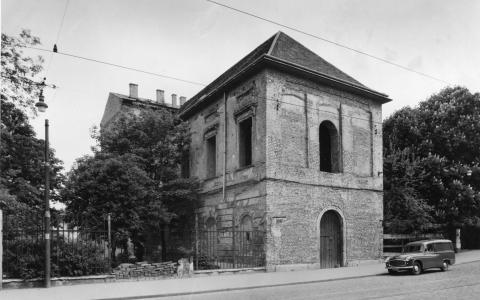The chapel, built in 1727 by Johann Lucas von Hildebrandt and dedicated to St. Januarius, belonged to Alois Thomas Raimund Count Harrach (1669-1742). The building had been owned by the Austrian government since the late 1920s, and from November 1940 it belonged to the police administration of the German Reich. On 17 September 1946, the St. Januarius Chapel, which had almost completely burned down in May 1945, was returned to Austrian state ownership at the instigation of the Financial Directorate (FLD). In the 1960s, the listed building, which now belongs to the Bundesimmobiliengesellschaft (Federal Real Estate Company), was under the administration of the Post and Telegraph Directorate.
As the Office of the Salzburg Provincial Government was seeking to clear the smoking room at Schloss Kleßheim, to which art objects of unknown provenance had been transferred from the Central Collecting Point in Munich in January 1952 (the so-called Munich Restbestand), the Federal Monuments Office (BDA) was commissioned by the tax authorities in December 1960 to find a new storage space for the artworks. The BDA chose the former sacristy of the St. Januarius Chapel in Vienna’s 3rd district, located at Ungargasse 69, which had been partially restored by the BDA after the war. In April 1961, Erika Doberer, the BDA employee responsible for the relocation, had the 135 paintings from Schloss Kleßheim as well as around 500 framed pictures, ten portfolios of prints, 13 sculptures and around 30 decorative arts objects moved from the cellar depot of the Salzburg Residence to the St. Januarius Chapel. After the art objects had been stored, Edith Podlesnigg and Hans Foramitti, both of whom worked for the BDA, carried out an inspection on 21 April 1961. Due to the concerns they expressed about the humidity in the chapel, Erwin Thalhammer, head of the cultural department in the Ministry of Education, and Gertrude Tripp from the BDA decided to transfer the more valuable works of art to other institutions for storage. On 16 May 1961, the Academy of Fine Arts took over the graphic art holdings and the library into fiduciary custody. The decorative art objects, such as five tapestries and eleven smaller textiles, went to the Museum of Applied Arts (MAK) on 18 May 1961. The BDA deposited 43 paintings and two sculptures in its own depot at Löwelstraße 20. The less valuable objects remained in the chapel. Due to the Federal Ministry of Finance's preparations for the Art and Cultural Assets Consolidation Act, which was to come into force on 1 September 1969, the art objects remaining in the St. Januarius Chapel were relocated to the Mauerbach Charterhouse in 1965, together with those from the other BDA depots (Löwelstraße 20, Neue Burg, Arsenal Object 15, Amtliche Werkstätten). The St. Januarius Chapel then stood empty until its reconstruction in 1985-1987 and is now part of a school complex.

